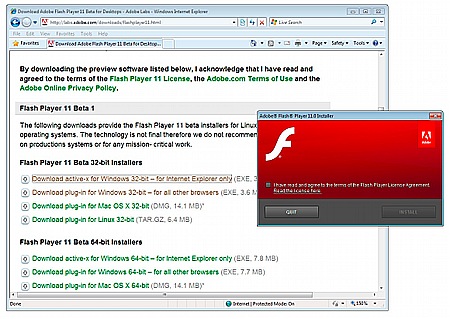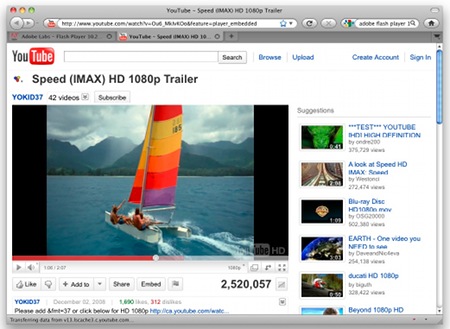Flash Player 11 beta returns to 64-bit Linux
Jul 14, 2011 — by LinuxDevices Staff — from the LinuxDevices Archive — 4 viewsAdobe has released a beta of Flash Player 11, touting 64-bit support across Windows, Mac OS, and — after a year-long hiatus — Linux. The software includes a new set of low-level APIs for GPU (graphical processing unit) acceleration, H.264/AVC and H/264 compression technologies, cross-platform vector printing, a secure random number generator, according to the company.
Adobe's Flash Player is described as a "a cross-platform browser-based application runtime that provides uncompromised viewing of expressive applications, content, and videos across screens and browsers." Once associated mainly with interactive ad banners and simple games, it has become a mainstay of web video, offered by sites like Hulu, YouTube, and countless others.
Flash Player 11 has been available in a Flash Player Incubator version, but moved to a full public beta as of July 13. It consists of a runtime — for Windows, Macintosh, and Linux desktops — that allows users to test existing content; a revised SDK (software development kit) does not yet appear to have been provided.
64-bit Linux gets its Flash back
It seems Linux users will be the most to gain from the new release, since Flash Player 11 now includes both 32- and 64-bit support for that operating system (as, once again, it also does for Windows and Mac OS). In addition, vector printing — for "crisp and sharp" images — is now supported on Linux as well as the other two platforms, according to Adobe.
In June 2010, when the 32-bit Flash Player 10.1 for Windows, Linux, and Mac went final, Adobe disappointed 64-bit Linux users when it announced that it was temporarily ending beta development of Flash 10.1 for 64-bit Linux, which had been promised back in 2008. The company said only that it needed to add more security enhancements, but added that it would eventually ship a 64-bit version of Flash for Linux.
As The Register notes today, the release of the 64-bit Linux beta will not completely assuage the penguins' ruffled feathers, as last month Adobe terminated the Linux incarnation of its Flash-based AIR runtime "into the hands of OEMs." Adobe stated at the time that "its attempts to promote the runtime on Linux were far from successful," says the story. While some Linux developers have said good riddance to AIR, Flash, for all its flaws, is more difficult to live without.

Installing Flash Player 11
(Click to enlarge)
The Flash Player 11 beta also is said to include Stage3D APIs, previously codenamed "Molehill." These provide "a new method/model of 2D and 3D rendering" that will provide developers "the flexibility to leverage GPU hardware acceleration for significant performance gains."
According to Adobe, the Flash Player is currently capable of rendering thousands of non z-buffered triangles at approximately 30Hz. Once they adopt the new Stage3D APIs, developers can expect hundreds of thousands of z-buffered triangles to be rendered at HD resolution in full screen at around 60Hz, the company claims.
Adobe says Flash Player 11 also includes G.711 audio compression for telephony, plus H.264/AVC software encoding for video. The former supports interoperability with legacy phone system (through the Flash Media Gateway) and other third-party clients (through the RTMP protocol) without transcoding; the latter provides improved compression and "industry-wide support" for streaming video from a computer's camera, the company adds.
More programmer-oriented new features are said to include:
- JSON (JavaScript Object Notation) — allows taking existing code written for the JSON interface provided by ECMAScript 5th edition and dropping the code, with minimal or no modification, into an Actionscript project
- Garbage Collection Advice — provides a simple facility with which AS3 code can advise the GC on when to schedule the disruptive end-of-GC pause
- Socket Progress Events — provides a means by which content can determine how many bytes remain in the AS Socket's write buffer
- Secure Random Number Generator — generates secure random numbers that are cryptographically as strong as the underlying operating system; will be used on both desktop and mobile platforms by Flash Platform Services
Background
Last February, Adobe released a final version of its Flash Player 10.2, touting new features such as support for full-screen mode on multiple monitors and support for more GPUs. According to AMD, it worked with Adobe to enable accelerated 1080p video decoding on the E-Series and C-Series APUs ("advanced processing units") that have been making their way into notebooks and a variety of embedded products.
At the time, Adobe said Flash Player 10.2's enhanced performance on the AMD APUs, as well as the other supported GPUs, was due to Stage Video, "a new method for video playback." This "dramatically decreases" processor usage and also lowers the amount of RAM flash requires, the company claimed.

A demonstration of Adobe's Flash Player 10.2 playing back 1080p video
(Click to enlarge)
According to Adobe's release notes, when Flash Player 10.2 video playback is switched into full-screen mode on a secondary monitor, it will remain that way even when user are doing work on their main screens. (In our brief testing of the upgrade, this proved to be true, though not with Firefox 3 — a known issue, said Adobe.)
Other improvements in Flash Player 10.2 included the ability for developers to define custom native mouse cursors, security enhancements, and improved text readability, according to Adobe. Flash Player also now takes advantage of hardware-accelerated graphics in Internet Explorer 9, "utilizing hardware rendering surfaces to improve graphics performance and enable seamless composition," the company said.
According to Adobe, Flash Player 10.2 dropped support for Windows 2000 and PowerPC-based clients. The latter was because of "performance enhancements that cannot be supported on the older PowerPC architecture," the company says.
The company's previous Flash Player 10.1, was released in 2010. A key addition at the time was hardware decoding of H.264 video on computers using GPUs from AMD/ATI GPUs (Radeon HD and FirePro), Broadcom (Crystal HD BCM70012 and BCM70015), Intel (GMA500, 4 Series chipset, 2010 Core processors), and Nvidia (GeForce, Ion, and Quadro). At the time, however, GPU assistance wasn't available either on Linux or Mac OS X desktops.
Further information
The Flash Player 11 beta can be downloaded now from Adobe's website, and so can release notes in PDF formats.
Jonathan Angel can be reached at [email protected] and followed at www.twitter.com/gadgetsense.
This article was originally published on LinuxDevices.com and has been donated to the open source community by QuinStreet Inc. Please visit LinuxToday.com for up-to-date news and articles about Linux and open source.